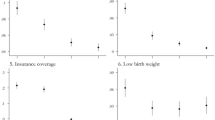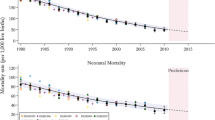Summary
Objectives
After unification in 1990 the two parts of Germany underwent a complex process that has led to convergence of infant mortality. The pattern of change did, however, differ in east and west. This study investigates whether these differences conceal a complex pattern of heterogeneity at the regional level.
Methods
Examination of routine data on infant, neonatal and postneonatal mortality. Time trends in the 16 federal states of Germany (Länder) from 1991 to 1997 were studied using a log-linear model.
Results
In 1991, infant mortality was higher in almost all eastern Länder than in the west. By 1997, this east-west gap had disappeared. Over this period, infant mortality fell in all Länder but one. The decline was steepest in the east, ranging from 31% to 52%. Improvements were largely due to steep declines in both neonatal and postneonatal mortality.
Conclusions
This study shows that, at the time of unification, there was an almost complete demarcation between east and west, a pattern that disappeared by 1997. There is, however, still a substantial regional variation in infant mortality that is largely determined by postneonatal mortality.
Zusammenfassung
Fragestellung
Seit der Vereinigung im Jahr 1990 haben die beiden Teile Deutschlands einen komplexen Prozess in Bezug auf Säuglingssterblichkeit durchlaufen, wobei das Muster dieses Wandels in Ost und West verschieden war. Die vorliegende Studie untersucht, inwieweit diese Unterschiede Heterogenität auf regionaler Ebene maskieren.
Methoden
Analyse von Routinedaten zur Säuglings-, neonatalen und postneonatalen Sterblichkeit in den 16 Bundesländern im Zeitraum 1991 bis 1997. Als Analyseinstrument kommt ein log-lineares Regressionsmodell zur Anwendung.
Ergebnisse
Im Jahr 1991 war die Säuglingssterblichkeit in fast allen neuen Bundesländern höher als in den alten Ländern. Dieser Ost-West-Gradient hat sich jedoch zum Jahr 1997 aufgelöst, wobei die Säuglingssterblichkeit mit einer Ausnahme in allen Ländern über den genannten Zeitraum zurückgegangen ist. Mit einer Verminderung um 31% bis 52% war dieser Prozess in den in den neuen Ländern am deutlichsten ausgeprägt. Rückgänge der Säuglingssterblichkeit waren bedingt durch Verbesserungen der neonatalen wie auch der postneonatalen Sterblichkeit.
Schlussfolgerungen
Zum Zeitpunkt der Vereinigung bestand ein deutlicher Ost-West-Gradient in der Säuglingssterblichkeit, 1997 jedoch nicht mehr. In Deutschland besteht nach wie vor eine deutliche regionale Variation in der Säuglingssterblichkeit, die vor allem durch Unterschiede in der postneonatalen Sterblichkeit bedingt ist.
Résumé
Objectifs
Après leur réunification en 1990, les deux parties de l'Allemagne ont subit un processus complexe qui a fait convergé leurs taux de mortalité infantile. Les types de changements ont toutefois varié entre l'Est et l'Ouest. Cette étude investigue si ce phénomène dissimule un modèle complexe de différences régionales.
Méthodes
Examination de statistiques de routine de mortalité infantile, néonatale, postnéonatale. Les variations observées entre 1991–1997 dans les 16 états fédéraux d'Allemagne (Länder) ont été étudiées par régression linéaire.
Résultats
En 1991, la mortalité infantile était plus élevée dans presque tous les Länder de l'Est que dans ceux de l'Ouest. En 1997, cet écart avait disparu. Pendant cette période, la mortalité infantile avait chuté dans 15 Länder. Le déclin était plus marqué dans l'Est (31–51%). Les améliorations s'expliquent principalement par une diminution marquée de la mortalité néonatale et postnéonatale.
Conclusions
Au moment de l'unification, il existait une démarquation Est-Ouest importante, mais celle-ci a disparu avant 1997. Toutefois, des variations régionales importantes dans la mortalité infantile demeurent et s'expliquent par des différences au niveau de la mortalité postnéonatale.
Similar content being viewed by others
References
Walberg P, McKee M, Shkolnikov V, Chenet L, Leon DA. Economic change, crime, and mortality crisis in Russia: regional analysis. BMJ 1998;317: 312–8.
Zatoñski WA, Boyle P. Health transformations in Poland after 1988. J Epidemiol Biostat 1996;1: 183–7.
McKee M, Zatoñski W. How the cardiovascular burden of illness is changing in Eastern Europe. Evidence-based Cardiovasc Med 1998;2: 39–41.
United Nations Children's Fund. After the fall. The human impact of ten years transition. Florence: UNICEF, 1999.
Leon DA, Vågerö D, Olausson PO. Social class differences in infant mortality in Sweden: comparison with England and Wales. BMJ 1992;305: 687–91.
Koupilová I, McKee M, Holèík J. Neonatal mortality in the Czech Republic during the transition. Health Policy 1998;46: 43–52.
Nolte E, Brand A, Koupilová I, McKee M. Neonatal and postneonatal mortality in Germany since unification. J Epidemiol Commun Health 2000;54: 84–90.
Statistisches Bundesamt. Gesundheits- und Sozialwesen in Übersichten. Wiesbaden: Statistisches Bundesamt, 1995. (Sonderreihe mit Beiträgen für das Gebiet der ehemaligen DDR; H. 27).
Kleinman JC. State trends in infant mortality, 1968–83. Am J Public Health 1982;76: 681–7.
Kleinman JC. Methodological issues in the analysis of vital statistics. In: Kieley M, ed. Reproductive and perinatal epidemiology. Boca Raton: CRC Press, 1991: 447–68.
Kirkwood BM. Essentials of medical statistics. London: Blackwell Science, 1988.
Microsoft Excel Version 97. Redmond, WA: Microsoft Press, 1997.
SPSS for Windows, Release 9.0.1. Chicago: SPSS, 1999.
Statistisches Bundesamt. Bevölkerungsstruktur und Wirtschaftskraft der Bundesländer 1998. Wiesbaden: Statistisches Bundesamt, 1998.
Bosche C, Genzel-Boroviczenczeny O, Hepp P, Knitza R, Versmold H, Roos R. Mortalität, Geburtsmodus, Pneumothorax und intrakranielle Blutungen bei 859 extrem Frühgeborenen zwischen 1984–1992. Geburtshilfe Frauenheilkunde 1996;56: 322–7.
Weiss E, Berle P. Analyse der perinatalen Mortalität als geburtshilflicher Leistungsparameter am Beispiel der hessischen Perinatalerhebung von 1981–1989. Geburtshilfe Frauenheilkunde 1993;53: 240–4.
Kalter HD, Na Y, O'Campo P. Decrease in infant mortality in New York City after 1989. Am J Public Health 1998;88: 816–20.
Racine AD, Joyce TJ, Wenhui L, Chiasson MA. Recent declines in New York City infant mortality rates. Pediatrics 1998;101: 682–8.
Künzel W. The birth survey in Germany-education and quality control in perinatalogy. Eur J Obstet Gynecol 1994;54: 13–20.
Projektgeschäftsstelle Qualitätssicherung bei der Landesärztekammer Brandenburg, ed. Perinatal- und Neonatalerhebung 1992–1999. Cottbus: Projektgeschäftsstelle Qualitätssicherung bei der Landesärztekammer Brandenburg, 2000.
McKee M, Fulop N, Bouvier P, et al. Preventing sudden infant death—the slow diffusion of an idaea. Health Policy 1996;37: 117–35.
Schlaud M, Eberhard C, Trumann B, et al. Prevalence and determinants of prone sleeping position in infants: results from two cross-sectional studies on risk factors for SIDS in Germany. Am J Epidemiol 1998;150: 51–7.
Beck L, Maier E, Schmidt E, et al. Mütter- und Säuglingssterblichkeit. Stuttgart: Kohlhammer, 1978. (Schriftenreihe des Bundesministers für Jugend, Familie und Gesundheit; Bd. 67).
Berentsen WH. German infant mortality 1960–1980. Geographical Rev 1987;77: 157–70.
Kemper FJ, Thieme G. Regional disparities of mortality in the Federal Republic of Germany. Espace Populations Societies 1991;1: 93–100.
Paul C. Sterblichkeit im regionalen Vergleich. Allgemeine Sterbetafeln der elf alten Bundesländer. Wirtschaft Statistik 1992;2: 82–7.
Casper W, Wiesner G, Bergmann K, eds. Mortalität und Todesursachen in Deutschland. Berlin: Robert Koch-Institut, 1995. (RKI-Heft; 10/1995).
Niehoff JU, Schneider F, Wetzstein E. Reflections of the health policy of the former German Democratic Republic. Int J Health Sci 1992;3: 205–13.
Author information
Authors and Affiliations
Rights and permissions
About this article
Cite this article
Nolte, E., Koupilová, I. & McKee, M. Temporal and spatial pattern of infant mortality in Germany after unification. Soz Präventivmed 46, 303–310 (2001). https://doi.org/10.1007/BF01321081
Issue Date:
DOI: https://doi.org/10.1007/BF01321081




